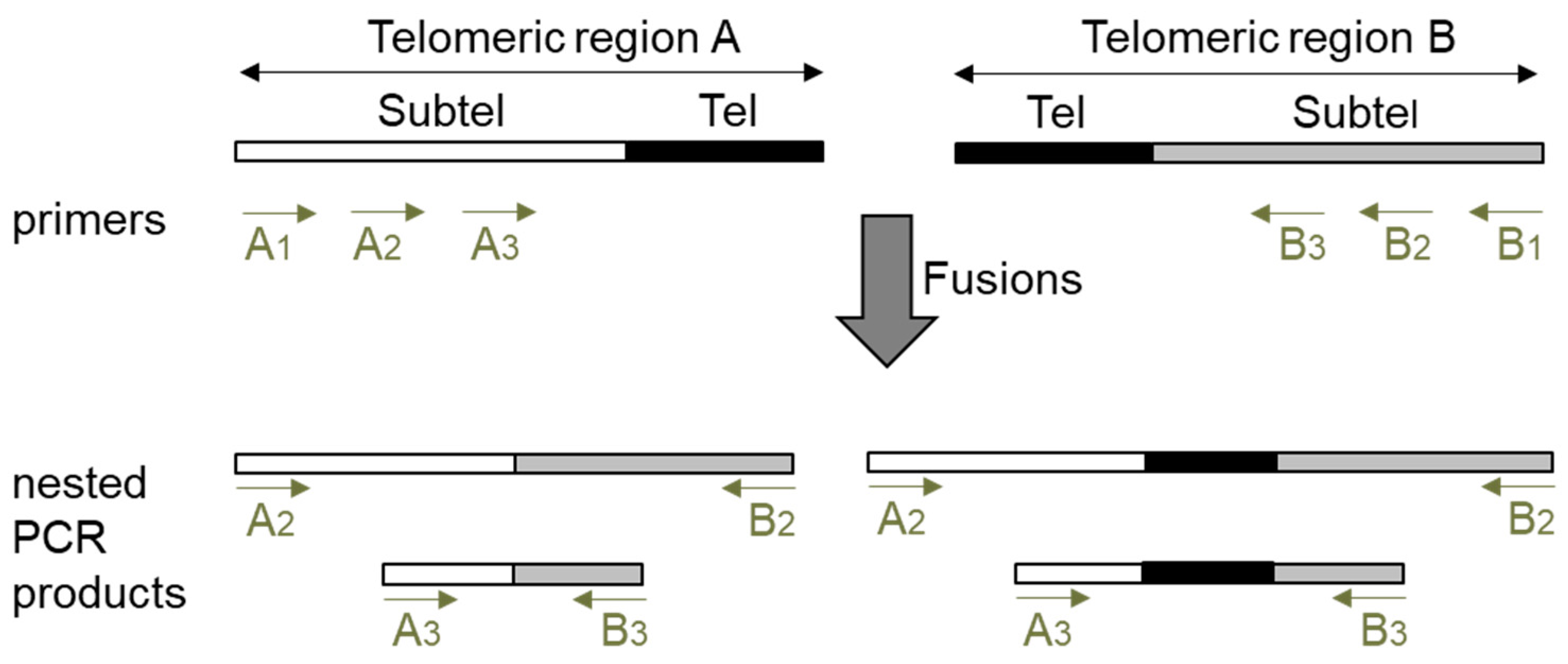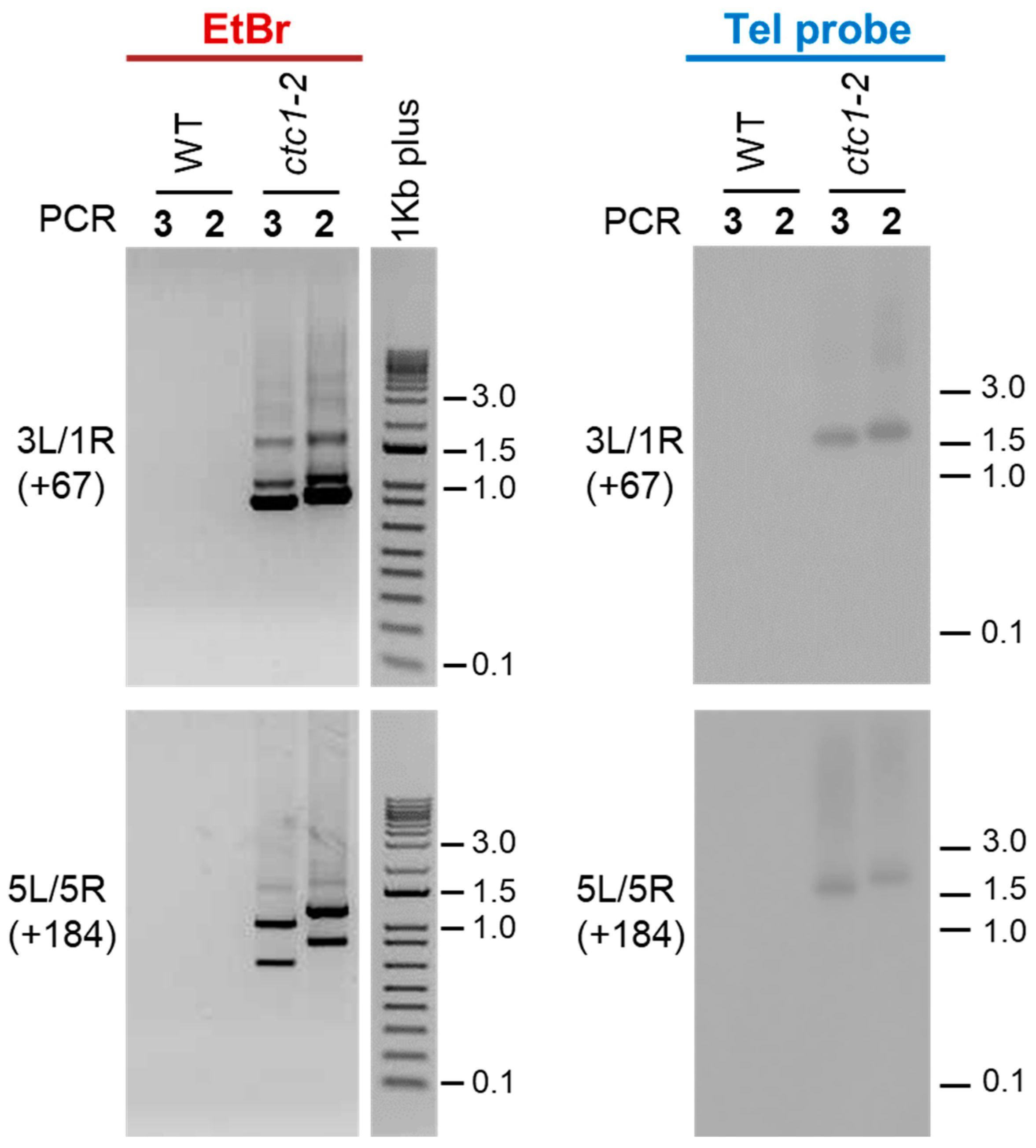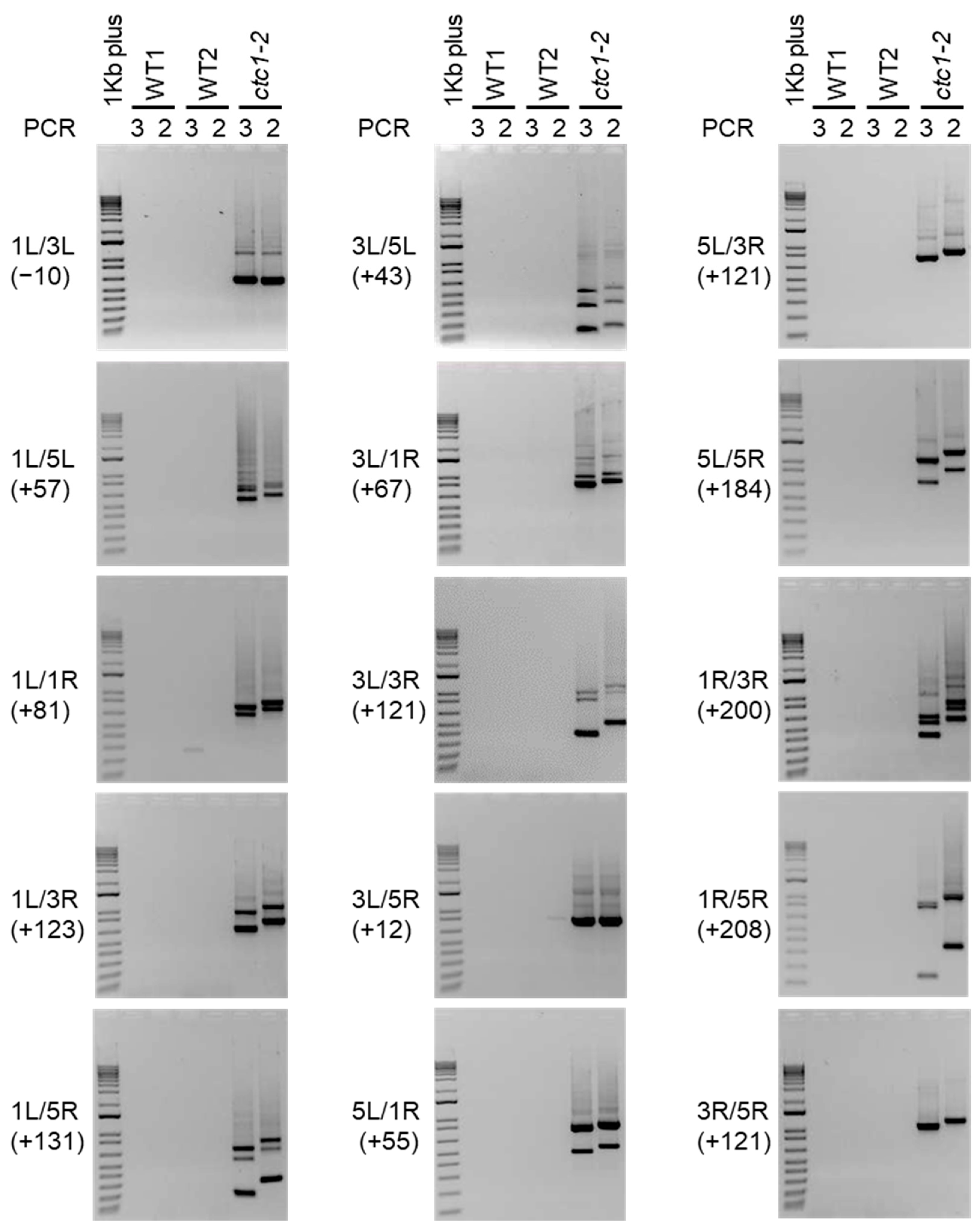A Nested PCR Telomere Fusion Assay Highlights the Widespread End-Capping Protection of Arabidopsis CTC1
Abstract
1. Introduction
2. Results
2.1. Design of a Nested PCR Procedure to Display Telomere Fusions
2.2. The Analysis of ctc1-2 Mutant Plants Validates the Nested PCR Technique
2.3. Nested PCR Analyses Highlight the Widespread End-Capping Protection of Arabidopsis CTC1
3. Discussion
4. Materials and Methods
4.1. Plant Materials and Growth Conditions
4.2. DNA Isolation and PCR Amplification
4.3. DNA Hybridization
5. Conclusions
Supplementary Materials
Author Contributions
Funding
Institutional Review Board Statement
Informed Consent Statement
Data Availability Statement
Acknowledgments
Conflicts of Interest
References
- Blackburn, E.H.; Epel, E.S.; Lin, J. Human Telomere Biology: A Contributory and Interactive Factor in Aging, Disease Risks, and Protection. Science 2015, 350, 1193–1198. [Google Scholar] [CrossRef] [PubMed]
- de Lange, T. Shelterin-Mediated Telomere Protection. Annu. Rev. Genet. 2018, 52, 223–247. [Google Scholar] [CrossRef] [PubMed]
- Lim, C.J.; Cech, T.R. Shaping Human Telomeres: From Shelterin and CST Complexes to Telomeric Chromatin Organization. Nat. Rev. Mol. Cell Biol. 2021, 22, 283–298. [Google Scholar] [CrossRef] [PubMed]
- Bhargava, R.; Lynskey, M.L.; O’Sullivan, R.J. New Twists to the ALTernative Endings at Telomeres. DNA Repair 2022, 115, 103342. [Google Scholar] [CrossRef] [PubMed]
- Lue, N.F.; Autexier, C. Orchestrating Nucleic Acid-Protein Interactions at Chromosome Ends: Telomerase Mechanisms Come into Focus. Nat. Struct. Mol. Biol. 2023, 30, 878–890. [Google Scholar] [CrossRef] [PubMed]
- Bailey, S.M.; Meyne, J.; Chen, D.J.; Kurimasa, A.; Li, G.C.; Lehnert, B.E.; Goodwin, E.H. DNA Double-Strand Break Repair Proteins Are Required to Cap the Ends of Mammalian Chromosomes. Proc. Natl. Acad. Sci. USA 1999, 96, 14899–14904. [Google Scholar] [CrossRef]
- Samper, E.; Goytisolo, F.A.; Slijepcevic, P.; van Buul, P.P.; Blasco, M.A. Mammalian Ku86 Protein Prevents Telomeric Fusions Independently of the Length of TTAGGG Repeats and the G-Strand Overhang. EMBO Rep. 2000, 1, 244–252. [Google Scholar] [CrossRef] [PubMed]
- Richards, E.J.; Ausubel, F.M. Isolation of a Higher Eukaryotic Telomere from Arabidopsis Thaliana. Cell 1988, 53, 127–136. [Google Scholar] [CrossRef]
- Kazda, A.; Zellinger, B.; Rössler, M.; Derboven, E.; Kusenda, B.; Riha, K. Chromosome End Protection by Blunt-Ended Telomeres. Genes Dev. 2012, 26, 1703–1713. [Google Scholar] [CrossRef]
- Nelson, A.D.L.; Shippen, D.E. Blunt-Ended Telomeres: An Alternative Ending to the Replication and End Protection Stories. Genes Dev. 2012, 26, 1648–1652. [Google Scholar] [CrossRef][Green Version]
- Riha, K.; Watson, J.M.; Parkey, J.; Shippen, D.E. Telomere Length Deregulation and Enhanced Sensitivity to Genotoxic Stress in Arabidopsis Mutants Deficient in Ku70. EMBO J. 2002, 21, 2819–2826. [Google Scholar] [CrossRef] [PubMed]
- Gallego, M.E.; Jalut, N.; White, C.I. Telomerase Dependence of Telomere Lengthening in Ku80 Mutant Arabidopsis. Plant Cell 2003, 15, 782–789. [Google Scholar] [CrossRef] [PubMed]
- Zellinger, B.; Akimcheva, S.; Puizina, J.; Schirato, M.; Riha, K. Ku Suppresses Formation of Telomeric Circles and Alternative Telomere Lengthening in Arabidopsis. Mol. Cell. 2007, 27, 163–169. [Google Scholar] [CrossRef] [PubMed]
- Barbero Barcenilla, B.; Shippen, D.E. Back to the Future: The Intimate and Evolving Connection between Telomere-Related Factors and Genotoxic Stress. J. Biol. Chem. 2019, 294, 14803–14813. [Google Scholar] [CrossRef]
- Karamysheva, Z.N.; Surovtseva, Y.V.; Vespa, L.; Shakirov, E.V.; Shippen, D.E. A C-Terminal Myb Extension Domain Defines a Novel Family of Double-Strand Telomeric DNA-Binding Proteins in Arabidopsis. J. Biol. Chem. 2004, 279, 47799–47807. [Google Scholar] [CrossRef]
- Hwang, M.G.; Cho, M.H. Arabidopsis Thaliana Telomeric DNA-Binding Protein 1 Is Required for Telomere Length Homeostasis and Its Myb-Extension Domain Stabilizes Plant Telomeric DNA Binding. Nucleic Acids Res. 2007, 35, 1333–1342. [Google Scholar] [CrossRef]
- Schrumpfová, P.; Fojtová, M.; Fajkus, J. Telomeres in Plants and Humans: Not So Different, Not So Similar. Cells 2019, 8, 58. [Google Scholar] [CrossRef]
- Kusová, A.; Steinbachová, L.; Přerovská, T.; Drábková, L.Z.; Paleček, J.; Khan, A.; Rigóová, G.; Gadiou, Z.; Jourdain, C.; Stricker, T.; et al. Completing the TRB Family: Newly Characterized Members Show Ancient Evolutionary Origins and Distinct Localization, yet Similar Interactions. Plant Mol. Biol. 2023, 112, 61–83. [Google Scholar] [CrossRef]
- Shakirov, E.V.; Surovtseva, Y.V.; Osbun, N.; Shippen, D.E. The Arabidopsis Pot1 and Pot2 Proteins Function in Telomere Length Homeostasis and Chromosome End Protection. Mol. Cell. Biol. 2005, 25, 7725–7733. [Google Scholar] [CrossRef]
- Shakirov, E.V.; McKnight, T.D.; Shippen, D.E. POT1-Independent Single-Strand Telomeric DNA Binding Activities in Brassicaceae. Plant J. 2009, 58, 1004–1015. [Google Scholar] [CrossRef]
- Surovtseva, Y.V.; Shakirov, E.V.; Vespa, L.; Osbun, N.; Song, X.; Shippen, D.E. Arabidopsis POT1 Associates with the Telomerase RNP and Is Required for Telomere Maintenance. EMBO J. 2007, 26, 3653–3661. [Google Scholar] [CrossRef]
- Arora, A.; Beilstein, M.A.; Shippen, D.E. Evolution of Arabidopsis Protection of Telomeres 1 Alters Nucleic Acid Recognition and Telomerase Regulation. Nucleic Acids Res. 2016, 44, 9821–9830. [Google Scholar] [CrossRef]
- Kobayashi, C.R.; Castillo-González, C.; Survotseva, Y.; Canal, E.; Nelson, A.D.L.; Shippen, D.E. Recent Emergence and Extinction of the Protection of Telomeres 1c Gene in Arabidopsis Thaliana. Plant Cell Rep. 2019, 38, 1081–1097. [Google Scholar] [CrossRef]
- Song, X.; Leehy, K.; Warrington, R.T.; Lamb, J.C.; Surovtseva, Y.V.; Shippen, D.E. STN1 Protects Chromosome Ends in Arabidopsis Thaliana. Proc. Natl. Acad. Sci. USA 2008, 105, 19815–19820. [Google Scholar] [CrossRef] [PubMed]
- Surovtseva, Y.V.; Churikov, D.; Boltz, K.A.; Song, X.; Lamb, J.C.; Warrington, R.; Leehy, K.; Heacock, M.; Price, C.M.; Shippen, D.E. Conserved Telomere Maintenance Component 1 Interacts with STN1 and Maintains Chromosome Ends in Higher Eukaryotes. Mol. Cell. 2009, 36, 207–218. [Google Scholar] [CrossRef] [PubMed]
- Price, C.M.; Boltz, K.A.; Chaiken, M.F.; Stewart, J.A.; Beilstein, M.A.; Shippen, D.E. Evolution of CST Function in Telomere Maintenance. Cell Cycle 2010, 9, 3157–3165. [Google Scholar] [CrossRef] [PubMed]
- Leehy, K.A.; Lee, J.R.; Song, X.; Renfrew, K.B.; Shippen, D.E. MERISTEM DISORGANIZATION1 Encodes TEN1, an Essential Telomere Protein That Modulates Telomerase Processivity in Arabidopsis. Plant Cell 2013, 25, 1343–1354. [Google Scholar] [CrossRef] [PubMed]
- Heacock, M.; Spangler, E.; Riha, K.; Puizina, J.; Shippen, D.E. Molecular Analysis of Telomere Fusions in Arabidopsis: Multiple Pathways for Chromosome End-Joining. EMBO J. 2004, 23, 2304–2313. [Google Scholar] [CrossRef]
- Mokros, P.; Vrbsky, J.; Siroky, J. Identification of Chromosomal Fusion Sites in Arabidopsis Mutants Using Sequential Bicolour BAC-FISH. Genome 2006, 49, 1036–1042. [Google Scholar] [CrossRef]
- Farrell, C.; Vaquero-Sedas, M.I.; Cubiles, M.D.; Thompson, M.; Vega-Vaquero, A.; Pellegrini, M.; Vega-Palas, M.A. A Complex Network of Interactions Governs DNA Methylation at Telomeric Regions. Nucleic Acids Res. 2022, 50, 1449–1464. [Google Scholar] [CrossRef]
- Amiard, S.; Depeiges, A.; Allain, E.; White, C.I.; Gallego, M.E. Arabidopsis ATM and ATR Kinases Prevent Propagation of Genome Damage Caused by Telomere Dysfunction. Plant Cell 2011, 23, 4254–4265. [Google Scholar] [CrossRef] [PubMed]
- Boltz, K.A.; Jasti, M.; Townley, J.M.; Shippen, D.E. Analysis of Poly(ADP-Ribose) Polymerases in Arabidopsis Telomere Biology. PLoS ONE 2014, 9, e88872. [Google Scholar] [CrossRef] [PubMed][Green Version]
- Aklilu, B.B.; Peurois, F.; Saintomé, C.; Culligan, K.M.; Kobbe, D.; Leasure, C.; Chung, M.; Cattoor, M.; Lynch, R.; Sampson, L.; et al. Functional Diversification of Replication Protein A Paralogs and Telomere Length Maintenance in Arabidopsis. Genetics 2020, 215, 989–1002. [Google Scholar] [CrossRef] [PubMed]
- Bose, S.; Suescún, A.V.; Song, J.; Castillo-González, C.; Aklilu, B.B.; Branham, E.; Lynch, R.; Shippen, D.E. TRNA ADENOSINE DEAMINASE 3 Is Required for Telomere Maintenance in Arabidopsis Thaliana. Plant Cell Rep. 2020, 39, 1669–1685. [Google Scholar] [CrossRef]
- Murray, M.G.; Thompson, W.F. Rapid Isolation of High Molecular Weight Plant DNA. Nucleic Acids Res. 1980, 8, 4321–4325. [Google Scholar] [CrossRef]
- Vaquero-Sedas, M.I.; Gámez-Arjona, F.M.; Vega-Palas, M.A. Arabidopsis Thaliana Telomeres Exhibit Euchromatic Features. Nucleic Acids Res. 2011, 39, 2007–2017. [Google Scholar] [CrossRef]



| Telomeric Region | Primer | DNA Sequence (5′–3′) | Distance to Telomere (bp) |
|---|---|---|---|
| 1L | 1L1 | CATGGAGGAATCACAGAACTATCA | 1373 |
| 1L | 1L2 | TTGCCACTTTCTGCTTCACAA | 1194 |
| 1L | 1L3 | GCCACTTTCTGCTTCACAAGTT | 1192 |
| 1R | 1R1 | GAATCTTGTGAGTGATGGAAGCT | 1406 |
| 1R | 1R2 | ACCACAATATGCCAGCTGTATC | 1376 |
| 1R | 1R3 | TGCACTTCTTCAGACTTAGTTATCC | 1297 |
| 3L | 3L1 | GCAAGATTTGGGTTTCCTCGTA | 1766 |
| 3L | 3L2 | GAAGAAAGCAAGGTATATATTCTGATGA | 1700 |
| 3L | 3L3 | AGATAAAACAAAGAAGAAAGCAAGGT | 1712 |
| 3R | 3R1 | GCTTAGTTGCTTTCCCGACAA | 2205 |
| 3R | 3R2 | CTCAACTCCTTTAGTGCTAATTG | 2184 |
| 3R | 3R3 | ACGTACTCTTGTTACTTGCGTC | 2063 |
| 5L | 5L1 | ACTCTGAACCCTTTGAAATACATCA | 1381 |
| 5L | 5L2 | ATATCTGCTACCAGGAACATAC | 1345 |
| 5L | 5L3 | ATTGCAGAAGGTGAAAATTGGC | 1290 |
| 5R | 5R1 | ACGGCTACCTCAAGAAAATGC | 2233 |
| 5R | 5R2 | ATGTAGATAGATAACTCATCCTCATT | 2209 |
| 5R | 5R3 | TCGTGAAATCATCCCCAAATCG | 2080 |
| Telomere Fusion | PCR1 Primers | PCR2 Primers | PCR3 Primers | Expected Shift (bp) |
|---|---|---|---|---|
| 1L/3L | 1L1 + 3L1 | 1L2 + 3L2 | 1L3 + 3L3 | −10 |
| 1L/5L | 1L1 + 5L1 | 1L2 + 5L2 | 1L3 + 5L3 | +57 |
| 1L/1R | 1L1 + 1R1 | 1L2 + 1R2 | 1L3 + 1R3 | +81 |
| 1L/3R | 1L1 + 3R1 | 1L2 + 3R2 | 1L3 + 3R3 | +123 |
| 1L/5R | 1L1 + 5R1 | 1L2 + 5R2 | 1L3 + 5R3 | +131 |
| 3L/5L | 3L1 + 5L1 | 3L2 + 5L2 | 3L3 + 5L3 | +43 |
| 3L/1R | 3L1 + 1R1 | 3L2 + 1R2 | 3L3 + 1R3 | +67 |
| 3L/3R | 3L1 + 3R1 | 3L2 + 3R2 | 3L2 + 3R3 | +121 |
| 3L/5R | 3L1 + 5R1 | 3L3 + 5R3 | 3L2 + 5R3 | +12 |
| 5L/1R | 5L1 + 1R1 | 5L2 + 1R2 | 5L3 + 1R2 | +55 |
| 5L/3R | 5L1 + 3R1 | 5L2 + 3R2 | 5L2 + 3R3 | +121 |
| 5L/5R | 5L1 + 5R1 | 5L2 + 5R2 | 5L3 + 5R3 | +184 |
| 1R/3R | 1R1 + 3R1 | 1R2 + 3R2 | 1R3 + 3R3 | +200 |
| 1R/5R | 1R1 + 5R1 | 1R2 + 5R2 | 1R3 + 5R3 | +208 |
| 3R/5R | 3R1 + 5R1 | 3R2 + 5R3 | 3R3 + 5R3 | +121 |
Disclaimer/Publisher’s Note: The statements, opinions and data contained in all publications are solely those of the individual author(s) and contributor(s) and not of MDPI and/or the editor(s). MDPI and/or the editor(s) disclaim responsibility for any injury to people or property resulting from any ideas, methods, instructions or products referred to in the content. |
© 2024 by the authors. Licensee MDPI, Basel, Switzerland. This article is an open access article distributed under the terms and conditions of the Creative Commons Attribution (CC BY) license (https://creativecommons.org/licenses/by/4.0/).
Share and Cite
Vaquero-Sedas, M.I.; Vega-Palas, M.A. A Nested PCR Telomere Fusion Assay Highlights the Widespread End-Capping Protection of Arabidopsis CTC1. Int. J. Mol. Sci. 2024, 25, 672. https://doi.org/10.3390/ijms25010672
Vaquero-Sedas MI, Vega-Palas MA. A Nested PCR Telomere Fusion Assay Highlights the Widespread End-Capping Protection of Arabidopsis CTC1. International Journal of Molecular Sciences. 2024; 25(1):672. https://doi.org/10.3390/ijms25010672
Chicago/Turabian StyleVaquero-Sedas, María I., and Miguel A. Vega-Palas. 2024. "A Nested PCR Telomere Fusion Assay Highlights the Widespread End-Capping Protection of Arabidopsis CTC1" International Journal of Molecular Sciences 25, no. 1: 672. https://doi.org/10.3390/ijms25010672
APA StyleVaquero-Sedas, M. I., & Vega-Palas, M. A. (2024). A Nested PCR Telomere Fusion Assay Highlights the Widespread End-Capping Protection of Arabidopsis CTC1. International Journal of Molecular Sciences, 25(1), 672. https://doi.org/10.3390/ijms25010672






